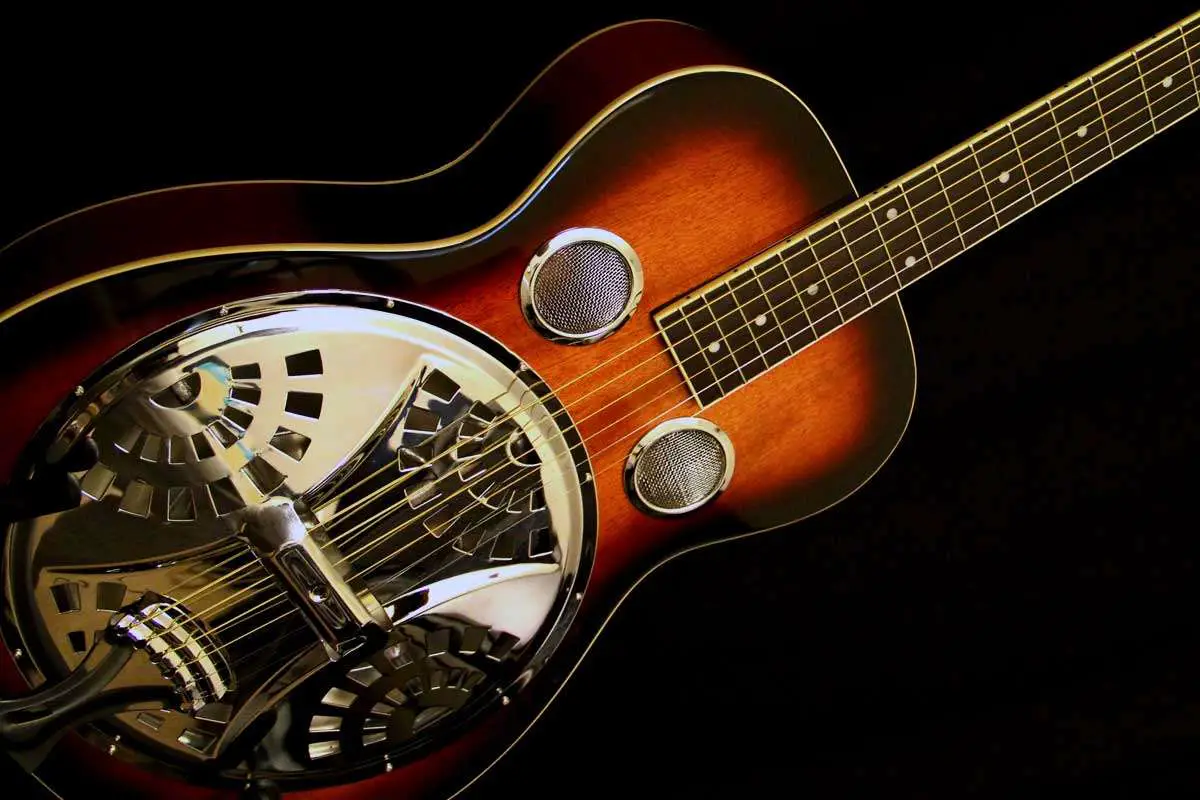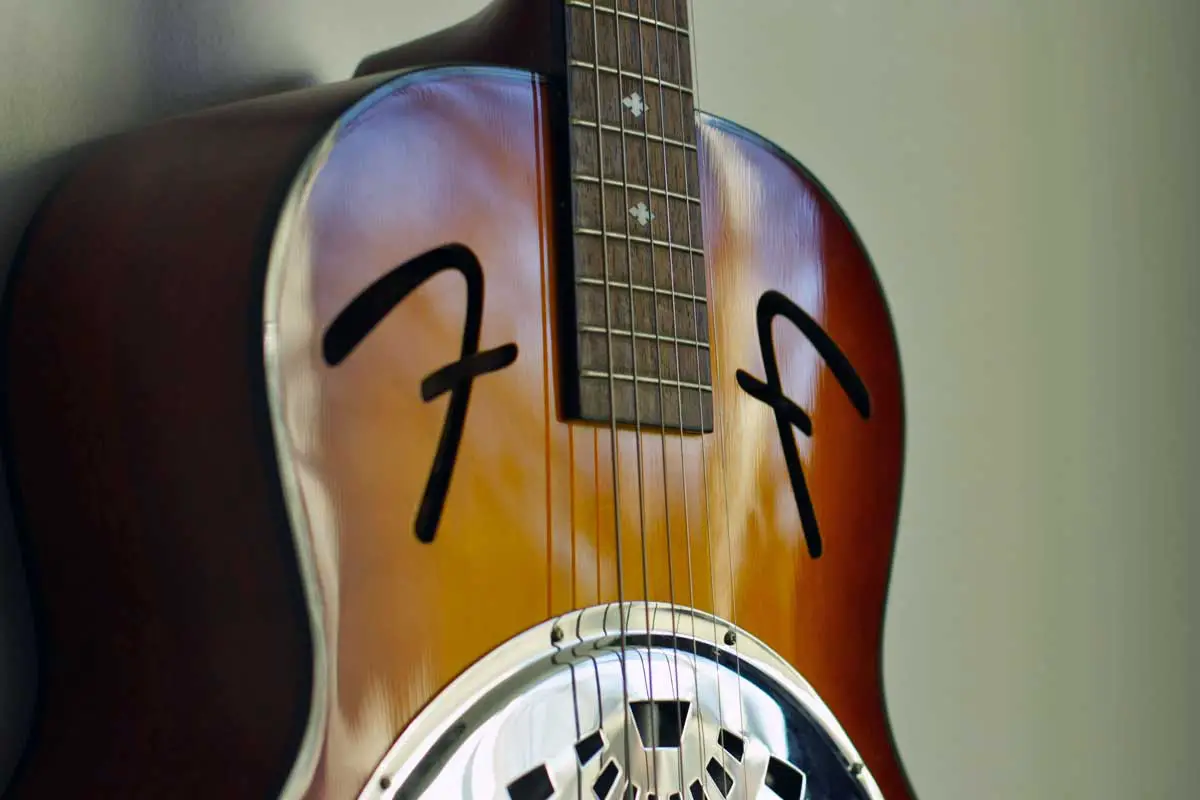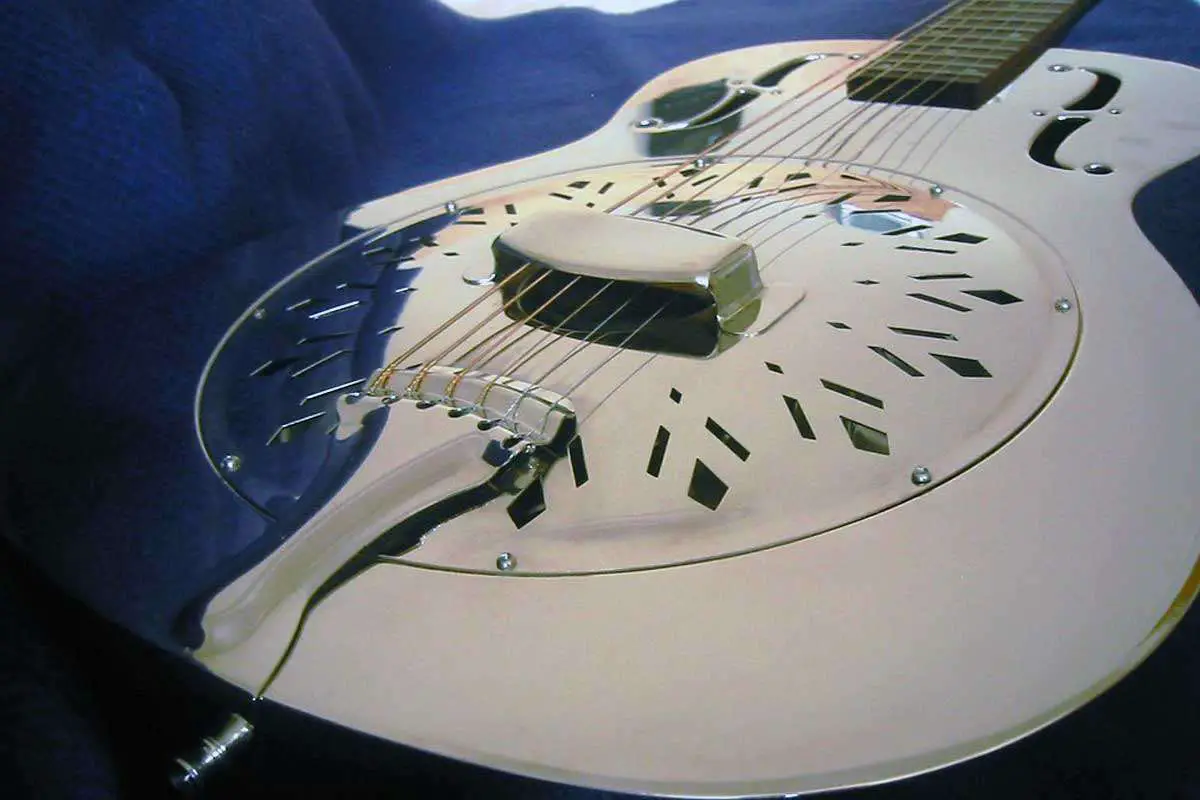If you’re a fan of acoustic guitars, you may have heard of the resonator guitar. But what is a resonator guitar exactly, and how does it differ from a traditional acoustic guitar?
In short, a resonator guitar is an acoustic guitar that produces sound by conducting string vibrations through one or more spun metal cones, instead of to the guitar’s sounding board. This unique design gives the resonator guitar a distinctive sound that sets it apart from other acoustic guitars.
The resonator guitar was first invented in the 1920s by John Dopyera, a Slovak-American luthier. Dopyera was looking for a way to create a guitar that could be heard over the loud horns and drums of jazz bands, and he came up with the idea of using a metal resonator cone to amplify the sound of the guitar. The first resonator guitars were made by the National String Instrument Corporation, which was founded by Dopyera and his brother. Today, resonator guitars are still popular among musicians who play blues, bluegrass, and other genres of music that require a unique, powerful sound.

History of Resonator Guitars
Resonator guitars were developed in the 1920s by John Dopyera, a Slovak-American luthier and inventor. Dopyera was approached by George Beauchamp, a vaudeville promoter, enlisted Dopyera’s services in developing a guitar that could produce a higher volume.. Dopyera responded by creating the first resonator guitar, which used a metal resonator cone to amplify the sound of the strings.
Dopyera went on to found the Dobro Manufacturing Company in 1928, which produced resonator guitars under the Dobro brand name. The Dobro became popular in the 1930s and was used extensively in country, blues, and Hawaiian music. The National String Instrument Corporation also began producing resonator guitars in the 1920s, and their tricone design became a popular alternative to the single-cone Dobro.
During the Great Depression, the popularity of resonator guitars declined as people could no longer afford expensive instruments. However, the resonator guitar experienced a revival in the 1960s and 1970s, when musicians like Eric Clapton, Duane Allman, and Jerry Garcia began using them in their music.
Today, resonator guitars continue to be popular among musicians who play blues, bluegrass, and other genres that require a loud, distinctive sound. Many companies now produce resonator guitars, including National Reso-Phonic Guitars, which was founded by McGregor Gaines & Don Young, a former employee of the National String Instrument Corporation.
Related: Who was the inventor of the electric guitar
Types of Resonator Guitars
When it comes to resonator guitars, there are three main types: Dobro, Tricone, and Single Cone. Each type has its own unique design and sound.
Dobro
Dobro is a brand name that has become synonymous with the single cone resonator guitar. The Dobro design features a single cone made of aluminum or steel, with a spider bridge that supports the cone. The strings are attached to a tailpiece that sits on top of the cone. The Dobro is known for its bright, metallic sound and is often used in bluegrass and country music.
Tricone
The tricone resonator guitar was the first design created by the National company. It features three small, interconnected cones that work together to amplify the vibrations of the strings. This design provides a unique, full-bodied sound that quickly gained popularity among musicians. Tricone resonator guitars are often used in blues and slide guitar playing.
Single Cone (Biscuit Bridge)
The single cone resonator guitar is similar to the Dobro design, but with a few key differences. Instead of a spider bridge, the single cone resonator guitar features a biscuit bridge. This design provides a warmer, more mellow sound than the Dobro. Single cone resonator guitars are often used in blues and country music.

Related: What is a microtonal guitar
Construction and Materials
Resonator guitars are built using two main materials: wood and metal. The body of the guitar may be made of wood, metal, or occasionally other materials. Typically there are two main sound holes, positioned on either side of the fingerboard extension.
Wooden Resonators
For the wooden ones, they use types of wood like mahogany, maple, and rosewood, just like regular acoustic guitars. These wooden bodies are treated with lacquer and paint to protect and beautify them. The resonator cones are usually made of metal, but there are also wooden resonator guitars with wooden cones. These wooden cones are often made of spruce, maple, or koa.
Metal Resonators
Metal resonators are made of brass, steel, or other metals. The metal cones direct the resonance of the guitar and produce a brighter tone than traditional steel-string acoustic guitars. The metal cones are spun into shape, which gives them their characteristic shape and sound. The spun metal cone is usually made of aluminum, but there are also cones made of brass or other metals.
The body of metal resonator guitars is also made of metal. The metal body is often made of brass or steel, and is usually plated with nickel or chrome. The metal body gives the guitar its unique sound, which is often described as metallic or twangy.
Mechanism of Sound Production
A resonator guitar produces sound by conducting string vibrations through the bridge to one or more spun metal cones (resonators), instead of to the guitar’s sounding board (top). The resonator acts like a speaker cone, which amplifies the sound produced by the strings.
The vibrations from the strings are transferred to the bridge, which is connected to a spider or biscuit bridge. The spider bridge is a metal device that holds the resonator cone in place. It is made up of a central hub and several arms, which are connected to the edges of the cone. The biscuit bridge, on the other hand, is a wooden device that sits on top of the resonator cone, and is held in place by the strings.
The spider or biscuit bridge transfers the vibrations from the strings to the resonator cone. The cone vibrates, which produces sound waves that are then projected out of the resonator. The sound waves produced by the resonator are different from those produced by a traditional acoustic guitar because they are brighter and more focused.
The resonator cone is typically made of aluminum, but it can also be made of other materials such as glass or ceramic. The shape and size of the cone, as well as the number of cones used, can affect the sound produced by the guitar.

Playing Techniques & Styles
There are various techniques and styles you can use when playing a resonator guitar. In this section, we will discuss two of the most common techniques: slide and strumming.
Slide Technique
The slide technique involves using a slide, typically made of glass or metal, to play notes on the guitar. To use the slide technique, you simply place the slide on your finger and slide it up and down the fretboard to create different pitches. This technique is often used in blues, bluegrass, and country music.
One of the most popular styles of slide guitar is the Delta Blues style. This style involves using a bottleneck slide on the guitar to create a distinctive sound. To play Delta Blues, you typically use a fingerpicking technique and play the guitar in an open tuning, such as open D or open G.
Related: The basics of guitar tunings
Strumming Technique
The strumming technique involves using a pick or your fingers to strum the strings of the guitar. This technique is often used in country, bluegrass, and folk music. When strumming, you can play chords or individual notes to create a melody.
To play country music on a resonator guitar, you typically use a flatpick and strum the strings in a steady rhythm. Bluegrass music, on the other hand, often involves using a fingerpicking technique and playing fast, intricate melodies.
Resonator Guitars in Music Genres
Resonator guitars have a unique sound that has been utilized in many different music genres. Whether you are playing blues, bluegrass, country, or any other genre, a resonator guitar can add a distinct and powerful element to your music.
Blues
Blues music has a long history with resonator guitars. In the early days of the blues, resonator guitars were often used by street musicians who needed a loud and powerful instrument to be heard over the noise of the city. As blues music evolved, resonator guitars became a staple of the genre.
Resonator guitars are often used in Delta blues, a style of blues that originated in the Mississippi Delta region. The raw and gritty sound of a resonator guitar perfectly complements the emotion and intensity of Delta blues.
Bluegrass
Bluegrass music is another genre that has a strong connection to resonator guitars. The bright and twangy sound of a resonator guitar is a perfect fit for the fast-paced and intricate melodies of bluegrass music.
Resonator guitars are often used in bluegrass bands as a lead instrument, and they are particularly well-suited for playing solos. The unique sound of a resonator guitar can cut through the mix of other instruments and really shine in a bluegrass setting.
Country
Resonator guitars have a long history in country music as well. In the early days of country music, resonator guitars were often used as a substitute for the more expensive and harder-to-find acoustic guitars.
Today, resonator guitars are still used in country music, particularly in the more traditional styles of the genre. The twangy and resonant sound of a resonator guitar can add a lot of character and depth to a country song.
Other Genres
While resonator guitars are most commonly associated with blues, bluegrass, and country music, they have been used in many other genres as well. Resonator guitars have been used in rock, folk, and even jazz music.
In recent years, resonator guitars have seen a resurgence in popularity, with many modern musicians incorporating them into their music. Whether you are playing traditional or modern music, a resonator guitar can be a unique and powerful addition to your sound.

Famous Brands and Models
If you’re looking to buy a resonator guitar, there are many great brands and models to choose from. Here are two of the most famous ones:
Gretsch G9201 Honey Dipper
The Gretsch G9201 Honey Dipper is a popular resonator guitar that is known for its great sound and beautiful design. It has a vintage look that is inspired by the resonator guitars of the 1930s, and it is made with high-quality materials that ensure that it will last for years.
One of the standout features of the Gretsch G9201 Honey Dipper is its bell brass body, which gives it a warm and rich tone. It also has a rosewood fingerboard and a mahogany neck, which make it comfortable to play.
National Reso-phonic
National Reso-Phonic is a company that specializes in making resonator guitars, and they are known for their high-quality instruments. Their guitars are handmade in California, and they are made with the finest materials available.
One of the most famous models from National Reso-Phonic is the Style O. This guitar has a distinctive look that is instantly recognizable, with its metal body and single cone resonator. It has a loud and clear sound that is perfect for blues and country music.
Overall, there are many great brands and models of resonator guitars to choose from. Whether you’re looking for a vintage-style guitar like the Gretsch G9201 Honey Dipper or a handmade instrument from National Reso-Phonic, you’re sure to find a guitar that meets your needs.
Comparison with Other Instruments
When it comes to string instruments, there are a variety of options to choose from. In this section, we will compare resonator guitars to other popular instruments like acoustic guitars, electric guitars, banjos, and mandolins.
Acoustic Guitars
Acoustic guitars are similar to resonator guitars in that they are both acoustic instruments that produce sound without the use of an amplifier. However, acoustic guitars have a hollow body and a soundhole in the top, which allows the sound to resonate within the body of the guitar. In contrast, resonator guitars have one or more spun metal cones that amplify the sound produced by the strings.
Electric Guitars
Electric guitars are quite different from resonator guitars in terms of their construction and sound. Electric guitars use pickups to convert the sound of the strings into an electrical signal, which is then amplified through an amplifier. This allows for a much louder sound than can be achieved with an acoustic instrument. Resonator guitars, on the other hand, are still acoustic instruments, but they have a unique sound that is different from both acoustic and electric guitars.
Banjos
Banjos are another popular string instrument that is often used in bluegrass and folk music. Like resonator guitars, banjos have a unique sound that is quite different from other string instruments. Banjos have a round body with a drum-like head that is stretched over the top. They also have a long neck with frets, similar to a guitar. Banjos are typically played with a technique called “clawhammer,” which involves striking the strings with the back of the fingernail.
Mandolins
Mandolins are similar to banjos in that they have a round body and a long neck with frets. However, mandolins are tuned differently and have a brighter, more treble-heavy sound than banjos. Mandolins are often used in bluegrass and folk music, and they are typically played with a pick.
Choosing the Right Resonator Guitar
When it comes to choosing the right resonator guitar, there are a few things to consider. Here are some factors to keep in mind:
Round Neck vs Square Neck
One of the first decisions you’ll need to make is whether you want a round neck or a square neck resonator guitar. Round neck models are designed to be played like conventional Spanish guitars, while square neck models are played like a lap steel. If you plan on playing slide guitar, a square neck resonator guitar is the way to go. However, if you prefer to play fingerstyle or use a pick, a round neck resonator guitar may be a better choice.
Neck Type
Another important factor to consider is the type of neck on the guitar. Some resonator guitars have necks made from mahogany, while others are made from maple or other types of wood. The type of neck you choose can have a big impact on the overall tone and feel of the guitar, so it’s important to choose one that feels comfortable and sounds good to you.
Action & Fretboard
The action and fretboard of a resonator guitar can also have a big impact on how it plays and sounds. The action refers to the distance between the strings and the fretboard, and a lower action can make it easier to play fast and intricate passages. The fretboard is the part of the guitar where you press down on the strings to make notes, and the type of wood used can affect the tone and sustain of the guitar.
Related: What Is A Guitar Tuner?
Other Considerations
Other factors to consider when choosing a resonator guitar include the type of resonator cone used, the body material (metal vs wood), and the overall build quality of the instrument. It’s also important to consider your budget and what you can afford, as resonator guitars can range in price from a few hundred dollars to several thousand.
In the end, the right resonator guitar for you will depend on your personal preferences and playing style. Take the time to try out different models and find one that feels and sounds great to you. With a little research and some careful consideration, you’re sure to find the perfect resonator guitar for your needs.
Related: What Is A Rhythm Guitar?
Maintaining and Amplifying Resonator Guitars
Resonator guitars are unique instruments that require specific maintenance to ensure they continue to produce their distinctive sound. Here are some tips on how to maintain and amplify your resonator guitar:
Maintenance
- Keep the guitar clean: Resonator guitars are made of metal, which can tarnish and rust over time. To keep your guitar looking and sounding its best, wipe it down after each use with a soft, dry cloth. Avoid using water or cleaning products, as these can damage the metal.
- Check the cones: The cones in a resonator guitar are what produce the sound. Over time, they can become damaged or loose. Check the cones periodically to make sure they are in good condition and securely fastened.
- Adjust the action: The action of a guitar refers to the distance between the strings and the fretboard. If the action is too high, the guitar may be difficult to play. If it’s too low, the strings may buzz against the frets. Adjust the action as needed to ensure the guitar is comfortable to play.
Amplification
- Use a resonator pickup: A resonator pickup is a device that attaches to the guitar and amplifies its sound. There are several types of resonator pickups available, including magnetic, piezo, and microphone pickups. Each has its own unique sound and characteristics.
- Choose the right amplifier: When choosing an amplifier for your resonator guitar, consider the type of music you will be playing. If you want a clean, crisp sound, choose a solid-state amplifier. If you prefer a warm, vintage sound, choose a tube amplifier.
- Experiment with reverb: Resonator guitars have a unique sound that can be enhanced with the use of reverb. Experiment with different types of reverb to find the one that best complements your guitar’s sound.
- Consider mic placement: If you plan to record your resonator guitar, consider the placement of the microphone. Placing the microphone near the sound hole or f-holes can produce a different sound than placing it farther away.
By following these tips, you can ensure your resonator guitar stays in top condition and produces the best possible sound.
Related: Why Do Guitarists Wear Wristbands?
